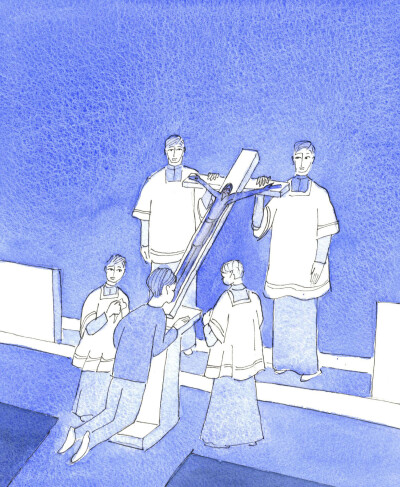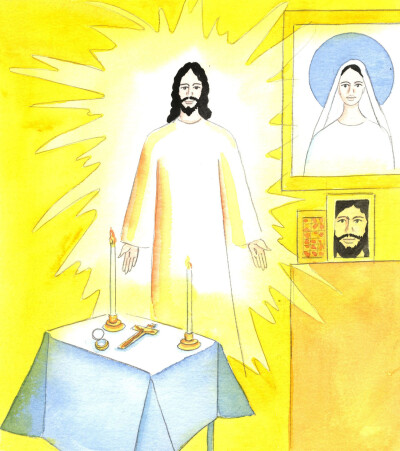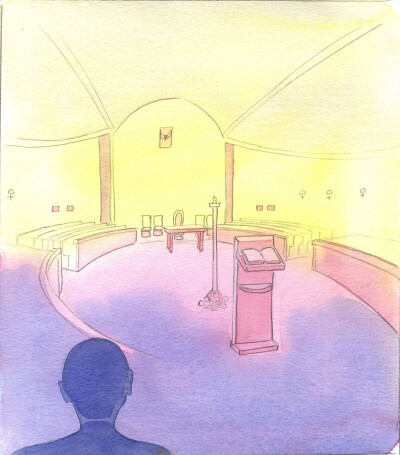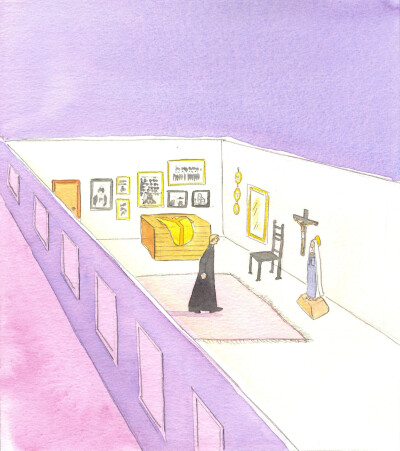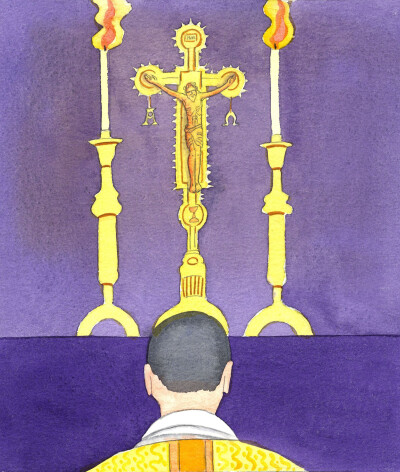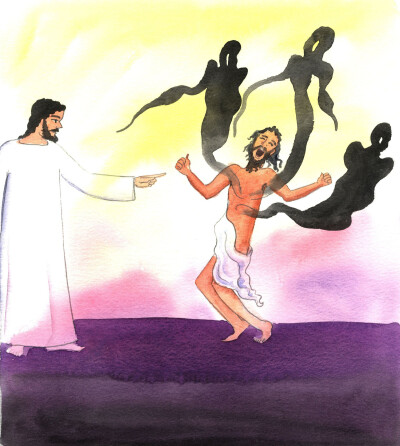Search Page
Showing 21 - 40 of 41
Christ held out to me a purple cloak, like the one which was draped over His shoulders before his crucifixion. He invited me to put it on, as a sign that I accept the sufferings which He asks me to endure in patience on the path ahead.
Christ is touched to the heart by every sign of devotion to Him in His Passion - which He endured out of love for us all. He wants us to revere the crucifix, pray the stations of the Cross, and make the sign of the Cross with reverence and care.
Christ is pleased to be honoured by preparation for His visit in Holy Communion to the housebound. Jesus stood in my room, as I waited to receive Him in Holy Communion. He showed me how joyful He was to be here. He gazed around Him, looking at the crucifix and the candles put out in His honour, and at the pictures of His Mother, and other Saints, nearby. He said: "IT IS GOOD TO BE HERE, WHERE I AM HONOURED". He meant, in a place where He is plainly held in high esteem as our God and Saviour: our joy and strength.
Some Catholic churches have neither a crucifix in them, nor a statue of Our Lady. Just as an art-lover would see it as a tragedy if all the pictures in a gallery were to have been cut out of their frames, so faithful Catholics are not wrong to call it a 'tragedy' when a new church is built - or an old one stripped - and those who pray there must face bare walls, without reminders of Gospel scenes, or Heavenly realities.
As the Lord gazes upon our world, it is His wish that the faithful can find, in their churches, visual reminders of what has really happened in history: for example, the infancy of Jesus Christ, and His Crucifixion. Why should Catholics look at bare walls, in Church, when they could have reminders of the foundation of the Faith?
The Lord pictured the contents of a sacristy, and asked: How would a priest feel, were treasured possessions to be ripped from the sacristy: photos of his silver jubilee Mass, his mother's crucifix, his favourite statue of Our Lady, his ordination photos, and special gifts? Why should his parishioners be expected to look on, calmly, as their favourite 'mementos', of statues and pictures, are condemned as so much rubbish?
At the Consecration, Christ said, of His Sacrifice on the Cross: "This is what sin did". He wants everyone to know that everyone who kills an unborn child commits a grievous sin. Each abortion is like the suffering meted out to Christ in His Passion: a crucifixion of the innocent.
If we are determined to withstand temptations and spiritual assaults, we will use holy water, which is a sacramental, blessed by the Church. It drives away demons. It is more than a reminder of our Baptism. Wise people keep it by them, as well as a crucifix, and a rosary. They know the help received through the prayers of the Blessed Virgin Mary, and through the name of Jesus.
The Lord wants to see a crucifix on every altar, large enough to serve as a reminder for everyone that they are present at a solemn, living memorial of His Sacred Passion and death. The Mass is therefore not an appropriate place for frivolity, pop music, dancing, or chatter, or anything else which would draw hearts and minds away from the awesome act which takes place.
Jesus Christ drove out evil spirits by a word of command. Such demons do exist, do infest and dominate people even today, and should not be regarded as figures in which only the superstitious can believe. We can find protection through the power of Jesus: His name, His crucifix, and holy water from His Church.
From the beginning, Christian life has been lived out using symbols and signs. What signs are there, in some modern churches, which have filthy entrances, and modernistic crucifixes, a hidden Blessed Sacrament, and no statue of Our Lady - in an area where people chat and cheer as if at a football rally. St. Pius X would be horrified by one church dedicated to his memory.
God's entire place of salvation leads us to the saving death of Christ, when we were given access to Heaven and to the Father through Christ. For a Christian to choose consciously not to pray through Christ, by joining in the prayer of non-Christian religions, is in effect to say that God's plan of salvation in Christ was not necessary. It is a way of denying our need for Christ.
If we try to escape the Cross, we merely flee into darkness. No Christian can expect to escape some sort of crucifixion, whether interior desolation and trials, and the dark nights, or persecution, or the knowledge of one's own sinfulness. The only way to sanctity and Heaven is upwards, with Christ, one with Him in crucifixion followed by Resurrection even in this life, to find fulfilment and joy in His service.
Holiness, by Elizabeth Wang
This text is the complete version of the pamphlet entitled 'SPEAK ABOUT HOLINESS'. It is based on a talk given by Elizabeth Wang.
Preface.
This little book contains the full version of the text I …
How to Pray: Basics, by Elizabeth Wang
This text is published as Chapter 2 of How to Pray (Part One: Foundations), pages 9-18, entitled 'How to Pray'. An introduction to the life of prayer with much practical advice about how to deepen you…
How to Pray: Catholic Devotions
This text is published as Chapter 6 of How to Pray (Part One: Foundations). An introduction to the life of prayer with much practical advice about how to deepen your prayer life.
6 ABOUT CATHOLIC …
Autobiography of Elizabeth Wang, Part 1
This text forms part of Elizabeth Wang's Falling in Love: A Spiritual Autobiography (1999). It tells the story of her life and of her spiritual journey as she came to know Christ and His Church.
You …
Autobiography of Elizabeth Wang, Part 2
This text forms part of Elizabeth Wang's Falling in Love: A Spiritual Autobiography (1999). It tells the story of her life and of her spiritual journey as she came to know Christ and His Church.
You …
Autobiography of Elizabeth Wang, Part 3
This text forms part of Elizabeth Wang's Falling in Love: A Spiritual Autobiography (1999). It tells the story of her life and of her spiritual journey as she came to know Christ and His Church.
You …
Autobiography of Elizabeth Wang, Appendix on Prayer
This text forms part of Elizabeth Wang's Falling in Love: A Spiritual Autobiography (1999). It tells the story of her life and of her spiritual journey as she came to know Christ and His Church.
You …
Showing 21 - 40 of 41


